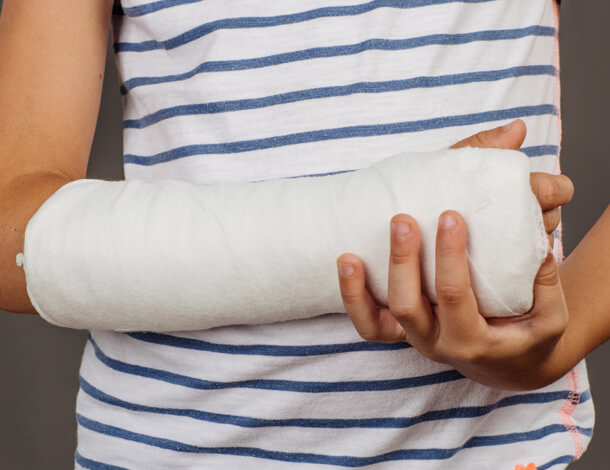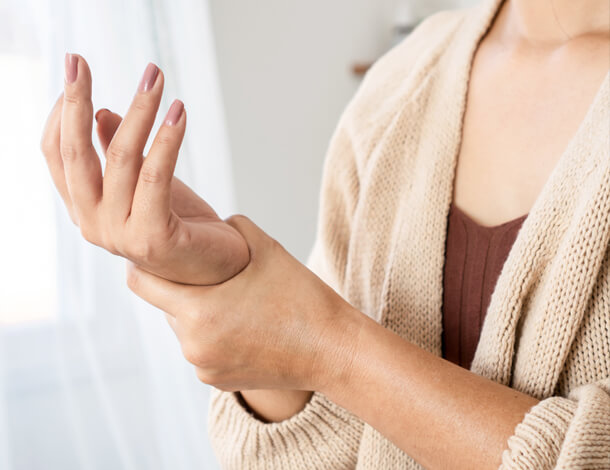Frostbite Injuries to the Hand
The most common form of cold induced tissue trauma is frostbite produced by temperatures usually around or below freezing. The sites of frostbite injury are usually restricted to the extremities and exposed body parts inadequately insulated from the cold. Factors that play a role in producing frostbite injuries are exhaustion, hyperventilation, loss of protective clothing, contact with moisture or bare metal, high velocity winds, dehydration and mechanical shear. Other factors include the presence of vascular disease or injury, smoking, a history of previous frostbite, conditioning, diet, co-existing injuries, intoxication and hypoxia.
Some of the more common scenarios leading to frostbite injuries are:
- The intoxicated individual who loses consciousness while outside,
- The individual working in an isolated area who becomes injured or otherwise incapacitated and is unable to seek aid or shelter on his own,
- The individual participating in outdoor sports without being properly dressed.
Frostbite will result when tissue temperatures reach -2°C (28°F) or less. The severity of tissue injury depends on the extent of tissue involvement, the tissue’s temperature and the duration of the cold exposure. Tissues differ in their resistance to cold injury with cartilage being the most sensitive followed by ligament, blood vessel, skin, bone, muscle, nerve and finally bone marrow. With skin being the most exposed of all tissues, its involvement in cold induced injury is most obviously apparent. As the skin begins to cool and approach freezing, a superficial blanching may develop sometimes known as frostnip. With proper rewarming, no injury to the tissues will result at this stage. Initially, frostbite is commonly heralded by a loss of cold discomfort and a feeling of warmth. It has been shown that sensory nerves are blocked by cold at tissue temperatures less than 10°C (50°F). This analgesic effect of cold may prevent the individual from being aware that frostbite damage is about to occur.
Simplistically, the severity of frostbite injuries can be divided into two groups: superficial, involving the skin only, or deep, involving the skin and underlying tissues. Two theories exist on the mechanism of injury in frostbite. A direct injury to the cells is produced by the formation of extracellular ice crystals. This appears to be an early event in the pathophysiology of the injury. Formation of ice crystals in the intercellular space increases its hypertonicity drawing water from the cells. Experimentally it appears that the duration of extracellular hypertonicity is the primary determinant of tissue injury.
As a consequence of this primary event, a secondary phenomenon of endothelial injury with thrombosis, hemo-concentration and increased viscosity then results. This secondary phenomenon further compromises the biochemical environment of the injured cells, impairs tissue perfusion, enhances local hypoxia and contributes to tissue edema on rewarming.
While mild cases of frostbite may involve only an isolated area inadequately protected from cold exposure, severe cases involving the hands and feet tend to occur simultaneously with hypothermia. Peripheral vasoconstriction occurs with a detected drop in tissue temperature. This is a protective mechanism designed to maintain the body’s core temperature. With continued cold exposure, periodic cold induced vasodilation will reperfuse and rewarm the tissue threatened by cold exposure. If, however, the body’s core temperature becomes threatened, shunting will cease with a continued drop in tissue temperature and eventual freezing.
Frostbite Treatment
The treatment of frostbite involves rapid rewarming by complete immersion of the frostbitten part in water at 40° to 42°C (104°-107°F) for 20 minutes or more. Remembering the association between severe frostbite and hypothermia, it may also be necessary to simultaneously rewarm the entire patient. This may require the use of heating blankets, warmed intravenous solutions or even warm peritoneal lavage. It is important that the temperature of the water be kept at a constant 40-42°C and not allowed to drop during the course of rewarming. This rapid rewarming can be painful to the patient and may require sedation or analgesia. Under no circumstances should any rubbing or shear of any kind be inflicted upon the injured part. These tissues are particularly vulnerable to sheer stress and this will only produce additional tissue injury.
Rewarming should never be initiated unless it can be carried to completion with appropriate medical attention. This is of particular importance in the management of an individual found in an isolated or desolate area with lower extremity frostbite. That individual can safely walk for miles to receive appropriate medical care on frostbitten feet without inflicting further injury. However, this same individual becomes a litter case if rewarming is initiated when the individual is first discovered. This is due to poor resistance to the mechanical shear stress of the rewarmed, frostbitten tissue. This shear could severely damage the individual’s feet should he attempt to walk.
Following rewarming, the frostbitten extremity should be placed in a bulky protective dressing and elevated. A program is then begun of twice daily whirlpool debridements with an antiseptic soap. Blisters that develop should not be ruptured but may be aspirated if they become excessively large. Systemic antibiotics are usually not indicated unless there is clinical evidence of infection. In the case of upper extremity frostbite, safe position splinting helps to avoid secondary joint contracture. Beyond elevation and the use of a lightly compressive dressing, other measures for edema control can be instituted as the injuries begin to heal. As pain and swelling permit, active range of motion should be started to the involved joints. Again, because of the poor resistance to shear injury, no passive motion should be attempted. Favorable signs in frostbite injuries include return of capillary filling, return of sensation and clear fluid blistering. Unfavorable signs include associated trauma, hemorrhagic blebs, cyanotic tissue distal to areas of blistering, failure to regain sensation and absence of edema. No surgical intervention is usually indicated earlier than two months unless infection occurs. Rarely does surgical management involve more than revision amputations although occasionally the release of joint or muscle contractures may be required. In most cases, tincture of time is the best treatment for these injuries.
Various adjuvant therapies have been utilized in the treatment of frostbite injuries to supplement rapid rewarming. These include sympathectomy, hyperbaric oxygen, anti-sludging agents and anti-inflammatories. Experimentally all of these adjuvant therapies can successfully limit the extent of tissue injury in frostbite but are most beneficial when initiated either prior to the injury or shortly after injury. In real life situations, this is usually not practical. We will use low molecular weight Dextran in the treatment of individuals with severe frostbite to the hands who are at risk of digital loss. Sympathectomy has been found of greatest value when used in the period three to 10 days following rewarming in individuals who are having difficulties with burning pain or causalgia.
Long-term complications of frostbite include a persistent burning, tingling pain in the injured part, profuse sweating, trophic ulceration, cold sensitivity and vasospasm. In young children, because of the sensitivity of cartilage, epiphyseal arrest can occur. In adults, the injury may produce degenerative arthritis in involved joints. Severe forms of frostbite may also, on rare occasions, produce intrinsic muscle contracture. Tissue, once frostbitten, tends to be more susceptible to injury on subsequent cold exposure.
The best treatment for frostbite is prevention. By avoiding extreme weather conditions and using appropriate protective clothing, the risk of frostbite can be minimized.
Therapeutic Management of the Hand Following Frostbite
Hand rehabilitation is an important aspect of the patient’s care following frostbite. Therapy will generally include: wound management, edema control, pain management, desensitization, use of modalities, proper splinting and exercises as indicated. Each of these treatment techniques are reviewed below.
Wound Management
Primary wound management is handled by the surgeon. The therapist does assist the surgeon in this area by providing the patient with whirlpools and wound care as indicated. The whirlpools are initiated early in the patient’s care and continued until the wound begins to heal. Following each whirlpool, silvadine cream is generally applied to the open wounds to promote wound healing. This is followed by the application of a light compressive dressing which both protects the wound and controls edema.
Edema Control
Edema is generally significant following frostbite. This is primarily due to freezing of tissues followed by rapid rewarming. This results in an excessive amount of fluid in the intercellular tissue spaces and subcutaneous tissues. Some of the treatment techniques utilized to control edema include use of light compressive dressings as mentioned above, as well as elastic stockinettes and custom-fit elastic Jobst gloves. The stockinettes and elastic gloves are never fitted to the patient until the wounds are closed.
Pain Control / Desensitization
One treatment method frequently used to help dampen the pain, which is somewhat pronounced during the early phase of therapy, is the use of Transcutaneous Electrical Nerve Simulation (TENS). Conventional TENS settings are generally used with the electrode placements along peripheral nerve distributions.
Manual desensitization is another means of quieting the pain and superficial skin hypersensitivity. This technique includes the use of various textures of cloth and contact media (e.g. lentil beans, rice, sand) which are rubbed along the entire extremity intermittently throughout the day. The patient progresses to more coarse textures and contact media as they can tolerate. This treatment method allows a bombardment of stimuli to the hypersensitive nerve endings of the skin, which are somewhat tactilely defensive to any type of stimuli.
Modalities
Modalities which we have found to be of value with frostbite patients include Functional Electrical Stimulation (FES), Fluidotherapy and Continuous Passive Motion (CPM) devices. FES is particularly valuable in enhancing tendon excursion. This also has some benefit in overriding joint contractures. Fluidtherapy is a dry heat modality which has minute, solid particles which swirl about the hand when the unit is turned on. Both the warmth (105°F) and the sensory bombardment to the hand are soothing and assist with decreasing hand sensitivity. As for CPM devices, they are a valuable treatment modality for increasing and/or maintaining passive motion to the digits.
Splinting
Proper immobilization of the hand in early care of frostbite is vital. The ideal position of immobilization is that of the “safe position.” The wrist is placed in 25° of dorsiflexion, the metacarpophalangeal joints in 75° of flexion, the interphalangeal joints are at neutral and the thumb is midway between radial and palmar abduction. This position maintains the joint collateral ligaments on maximum stretch, thus avoiding the likelihood of joint contractures developing. This is particularly true with the development of MP joint extension contractures, PIP joint flexion contractures, or that of a first web space contracture. This type of splinting should be worn between exercise sessions in the acute phase of therapy and then continued at night until scar maturation has occurred. This is generally between 4-6 months. Additional dynamic and/or static splinting may be necessary if there are specific joints slow to regain full range of motion.
Range of Motion
As soon as the initial pain and edema from the frostbite has begun to lesson, it is imperative to begin active and passive range of motion exercises to the entire upper extremity. Generally, exercise sessions 10-15 minutes each hour should be sufficient. To over exercise (i.e. over 15 minutes each hour) is contraindicated, for this will aggravate the hand edema.
Management of frostbite can be simple to relatively complex. The extent of the injury and the systemic response to cold are major influencing factors. The best approach is that of a team approach, with a close communication between the surgeon and the therapist regarding the patient’s course of hand management.



